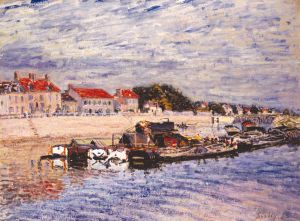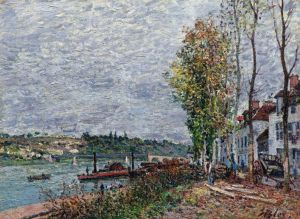
La rade de Cardiff
A hand-painted replica of Alfred Sisley’s masterpiece La rade de Cardiff, meticulously crafted by professional artists to capture the true essence of the original. Each piece is created with museum-quality canvas and rare mineral pigments, carefully painted by experienced artists with delicate brushstrokes and rich, layered colors to perfectly recreate the texture of the original artwork. Unlike machine-printed reproductions, this hand-painted version brings the painting to life, infused with the artist’s emotions and skill in every stroke. Whether for personal collection or home decoration, it instantly elevates the artistic atmosphere of any space.
"La rade de Cardiff" is an oil painting created by the French Impressionist artist Alfred Sisley in 1897. This work is one of the many landscapes painted by Sisley, who is renowned for his ability to capture the transient effects of light and atmosphere in his depictions of nature and urban scenes.
Alfred Sisley was born on October 30, 1839, in Paris, France, to British parents. He spent most of his life in France and became a key figure in the Impressionist movement, which sought to capture the momentary and sensory effects of a scene rather than its precise details. Sisley's works are characterized by their subtle use of color and light, and he often painted en plein air, or outdoors, to better capture the natural environment.
"La rade de Cardiff" depicts the Cardiff Docks, a significant port area in Cardiff, Wales. During the late 19th century, Cardiff was one of the world's largest coal-exporting ports, and its docks were bustling with industrial activity. Sisley's painting captures the essence of this busy maritime environment, with ships, cranes, and other dockside structures visible in the composition.
The painting is notable for its loose brushwork and the way Sisley captures the play of light on the water and the sky. The use of color is also significant, with the artist employing a palette that includes various shades of blue, gray, and brown to convey the atmosphere of the docks. The composition is balanced, with the horizon line placed relatively high, allowing the viewer to focus on the activity in the foreground.
Sisley's choice to paint the Cardiff Docks may have been influenced by his travels and the broader context of the industrial revolution, which was transforming landscapes across Europe. His ability to find beauty in industrial scenes is a testament to his skill as an artist and his commitment to the Impressionist ethos of capturing modern life.
"La rade de Cardiff" is housed in the Musée d'Orsay in Paris, which holds one of the most extensive collections of Impressionist and Post-Impressionist masterpieces. The museum's collection includes works by other prominent artists of the period, such as Claude Monet, Pierre-Auguste Renoir, and Edgar Degas.
Sisley's work, including "La rade de Cardiff," continues to be celebrated for its contribution to the Impressionist movement and its ability to convey the beauty of everyday scenes. His paintings are appreciated for their technical skill, their innovative use of color and light, and their ability to evoke a sense of place and time.
Alfred Sisley passed away on January 29, 1899, in Moret-sur-Loing, France. Despite facing financial difficulties throughout his life and not achieving the same level of fame as some of his contemporaries during his lifetime, Sisley's work has since been recognized for its importance and influence in the history of art.


















